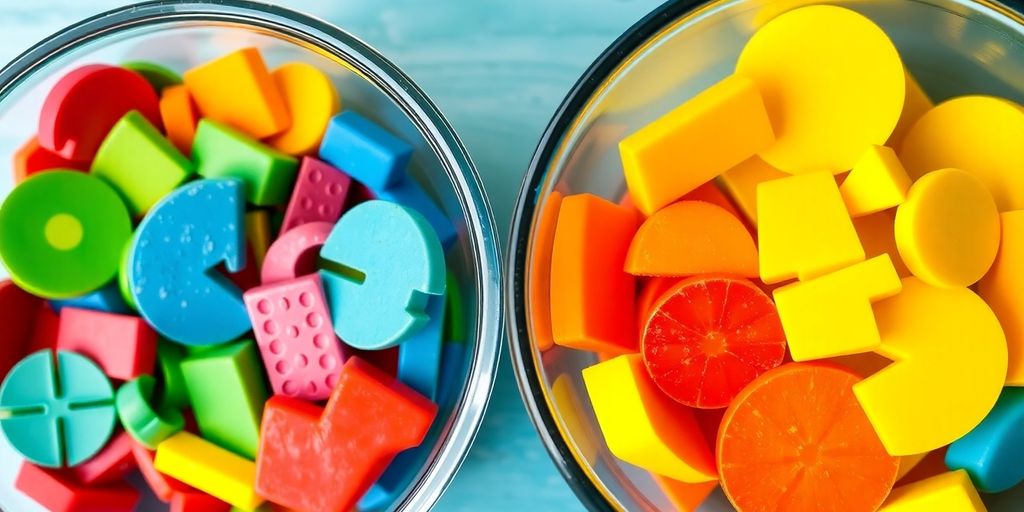Adding fractions might seem like a math puzzle, but it’s easier than you think. Whether you’re dealing with like or unlike denominators, or even mixed numbers, once you get the hang of it, it’s a breeze. This guide will walk you through the whole process, step by step.
You’ll learn how to add fractions in no time, and you’ll wonder why it ever seemed tricky.
Key Takeaways
- Understand the difference between like and unlike denominators.
- Learn to find a common denominator for adding, unlike fractions.
- Practice simplifying fractions after addition.
- Get comfortable converting improper fractions to mixed numbers.
- Apply these skills to real-world situations like cooking and carpentry.
How to Add Fractions – Understanding the Basics of Fractions

What Are Fractions?
Fractions are a way to represent parts of a whole. Picture a pizza cut into slices. If you have 3 out of 8 slices, you’d say you have 3/8 of the pizza. Fractions show us how many parts we have (the numerator) out of how many equal parts the whole is divided into (the denominator).
Numerator and Denominator Explained
The numerator is the top number in a fraction, indicating how many parts you have. The denominator is the bottom number, showing how many equal parts make up the whole. For instance, in 3/4, 3 is the numerator and 4 is the denominator. Remember, the numerator tells “how many,” and the denominator tells “of what.”
Importance of Learning Fractions
Understanding fractions is key for many daily tasks. Whether you’re cooking, measuring materials for a project, or managing time, fractions come into play. They help us to divide, share, and understand proportions better. Grasping fractions isn’t just about math—it’s about practical life skills.
Fractions might seem tricky at first, but once you get the hang of them, they become a useful tool in everyday life. It’s all about breaking things down into manageable pieces.
How to Add Fractions – Steps to Add Fractions with Like Denominators
Identifying Like Denominators
Before you can add fractions, you need to check if the denominators are the same. If you’re dealing with fractions like ( \frac{2}{7} ) and ( \frac{5}{7} ), you’re in luck because they already have like denominators. This means the bottom numbers of the fractions are the same, making the addition process much simpler. Identifying like denominators is crucial because it allows you to skip the extra step of finding a common denominator.
Adding the Numerators
Once you’ve confirmed that the denominators match, the next step is straightforward. You simply add the numerators together while keeping the denominator unchanged. For example, if you have ( \frac{2}{7} + \frac{5}{7} ), you add the numerators 2 and 5 to get 7, while the denominator remains 7. So, ( \frac{2}{7} + \frac{5}{7} = \frac{7}{7} ), which simplifies to 1.
Simplifying the Resulting Fraction
After adding the numerators, you might end up with a fraction that can be simplified. Simplifying means reducing the fraction to its lowest terms. In the previous example, ( \frac{7}{7} ) is already simplified to 1. But if you had a result like ( \frac{8}{4} ), you would simplify it to 2 by dividing both the numerator and the denominator by their greatest common divisor, which in this case is 4.
Adding fractions with like denominators is a breeze once you get the hang of it. Just remember, keep the denominator the same, add the numerators, and simplify if needed. It’s as simple as that!
How to Add Fractions with Unlike Denominators
Adding fractions with unlike denominators might seem tricky at first, but once you get the hang of it, it’s pretty straightforward. Let’s break it down into simple steps.
Finding a Common Denominator
When you’re dealing with fractions that don’t share the same bottom number or denominator, the first step is to find a common one. You do this by identifying the least common multiple (LCM) of the denominators. For example, if you’re adding 1/3 and 1/4, the denominators are 3 and 4. The LCM of 3 and 4 is 12.
Converting to Equivalent Fractions
Once you’ve found the common denominator, convert each fraction to an equivalent fraction with this new denominator. This means adjusting the numerators accordingly. So, for 1/3, you’d multiply both the top and bottom by 4 to get 4/12. For 1/4, multiply both by 3 to get 3/12.
Adding and Simplifying the Fractions
Now that both fractions have the same denominator, you can add them. Simply add the numerators together and keep the denominator the same. So, 4/12 + 3/12 becomes 7/12. If the resulting fraction can be simplified, go ahead and do that. In this case, 7/12 is already in its simplest form.
Remember, finding a common denominator is key. It turns a complex problem into a simple addition task.
How to Add Fractions – Adding Mixed Numbers: A Comprehensive Guide

Understanding Mixed Numbers
Mixed numbers are a combination of a whole number and a fraction. Think of them like 2 1/2 or 4 3/8. These are everywhere in real life, like when you’re measuring ingredients or dividing up a pizza. Grasping mixed numbers is crucial for adding them correctly.
Steps to Add Mixed Numbers
Here’s a simple way to add mixed numbers:
- Convert to Improper Fractions: First, change the mixed numbers into improper fractions. Multiply the whole number by the denominator, then add the numerator. For example, 3 1/4 becomes 13/4.
- Find a Common Denominator: If the denominators differ, find a common one. This might need some multiplying to make them match.
- Add the Fractions: With the common denominator in place, add the numerators. Keep the denominator the same.
- Convert Back to Mixed Numbers: If the sum is an improper fraction, turn it back into a mixed number by dividing the numerator by the denominator.
- Simplify the Result: Always check if the fraction part can be simplified.
Simplifying Mixed Number Results
After adding, you might end up with a fraction that can be simplified. Divide the numerator and the denominator by their greatest common factor (GCF) to make it simpler. It’s like cleaning up your work for a neat finish.
Adding mixed numbers might seem tricky, but with practice, it becomes second nature. Just remember to convert, find a common base, and simplify. Before you know it, you’ll be adding them like a pro!
For more on multiplying mixed numbers, check out this guide.
How to Add Fractions – Practical Applications of Adding Fractions
Cooking and Baking Measurements
When you’re in the kitchen, fractions are your best friend. Recipes often call for precise measurements like 1/2 cup of sugar or 3/4 teaspoon of salt. Adding fractions becomes crucial when you’re doubling a recipe or adjusting servings. Imagine you’re making a cake that needs 1/4 cup of oil, but you’re doubling the recipe. You’d need to add 1/4 to another 1/4, resulting in 1/2 cup. It’s simple math, but it makes all the difference in your cooking.
Construction and Carpentry Calculations
In construction, fractions are everywhere. Whether you’re measuring lengths of wood or spacing out nails, fractions help ensure accuracy. For example, if you have a piece of wood that’s 3/8 inch thick and you need to add another layer that’s 5/8 inch thick, you’d add 3/8 + 5/8 to get 1 inch. This kind of precise measurement is essential for creating sturdy structures.
Everyday Problem Solving with Fractions
Fractions pop up in daily life more than you might think. From splitting a bill among friends to planning your budget, adding fractions is a skill that comes in handy. Imagine you and a friend are sharing the cost of a gift. If one person contributes 1/3 of the cost and the other adds 2/3, together you’ve covered the whole expense. Understanding how to manage these fractions can make everyday tasks a breeze.
Fractions are not just a part of math class—they’re a part of life. Whether you’re cooking, building, or managing your finances, understanding fractions can make tasks easier and more efficient. Knowing how to add and work with them is a skill that pays off in countless ways.
For more insights on how fractions play a role in daily activities, especially in managing finances, check out this guide on the importance of fractions.
How to Add Fractions – Common Mistakes and How to Avoid Them
Misidentifying Denominators
One of the most common pitfalls when adding fractions is mixing up the denominators. Remember, the denominator is the bottom number of a fraction and tells you how many equal parts the whole is divided into. If you confuse these, your entire calculation can go off track. To avoid this, always double-check the denominators before you start adding. If they aren’t the same, you’ll need to find a common denominator first.
Forgetting to Simplify
After adding fractions, many people forget to simplify the result. Simplifying makes your fraction easier to understand and work with. For instance, if you end up with 6/8, you should simplify it to 3/4. To simplify, find the greatest common divisor (GCD) of the numerator and denominator and divide both by that number. This step is crucial for clear communication and easier calculations later on.
Incorrectly Adding Mixed Numbers
Adding mixed numbers can be tricky. A mixed number includes both a whole number and a fraction, like 2 1/3. The mistake often happens when folks try to add whole numbers and fractions separately without converting them properly. Here’s a quick tip: convert the mixed numbers into improper fractions first, then add. Once you’ve got your answer, convert it back to a mixed number if needed. This method keeps everything neat and avoids confusion.
Keep these common mistakes in mind the next time you’re adding fractions, and you’ll find the process much smoother. It’s all about taking a moment to double-check your work and understanding the steps involved.
How to Add Fractions – Practice Problems to Master Adding Fractions
Simple Fraction Addition Exercises
Let’s start with some simple exercises to warm up. These problems will help you get comfortable with adding fractions that have either the same or different denominators.
- Solution: (\frac{1}{2})
- Solution: (\frac{5}{6})
- Solution: (1)
Challenging Mixed Number Problems
Now, let’s tackle some mixed numbers. These require a bit more work, but they’re great for practicing your skills.
- Solution: (4\frac{1}{6})
- Solution: (5\frac{1}{4})
- Solution: (7\frac{1}{6})
Real-World Fraction Scenarios
Fractions pop up in real life more often than you might think. Here are some scenarios to help you see how useful this skill can be.
- Solution: (\frac{1}{4}) cup
- Solution: (5\frac{1}{4}) feet
- Solution: (\frac{2}{5}) of the way
Practicing with these problems will make adding fractions feel like second nature. Remember, the more you practice, the more confident you’ll become in your math skills. So, keep at it and watch your abilities grow!
How to Add Fractions – Wrapping It Up: Adding Fractions Made Easy
So there you have it, folks! Adding fractions isn’t as scary as it seems once you break it down into simple steps. Whether you’re dealing with like denominators unlike ones, or even those tricky mixed numbers, the key is to take it step by step. Remember, practice makes perfect. The more you work with fractions, the more natural it will feel. So next time you’re baking or helping with homework, you’ll be ready to tackle those fractions with confidence. Keep practicing, and soon enough, you’ll be adding fractions like a pro!
Frequently Asked Questions
What are fractions?
Fractions are parts of a whole. They show how many parts you have out of the total number of parts. For example, if you eat 1 out of 4 slices of pizza, you have eaten 1/4 of the pizza.
How do I add fractions with the same denominator?
To add fractions with the same denominator, simply add the numerators (the top numbers) together and keep the denominator (the bottom number) the same. For example, 1/4 + 2/4 = 3/4.
What if the denominators are different when adding fractions?
If the denominators are different, you need to find a common denominator before adding. This often involves finding the least common multiple of the denominators and converting the fractions to equivalent fractions with this common denominator.
How do you add mixed numbers?
To add mixed numbers, add the whole numbers together first, then add the fractions. If the fractions have different denominators, find a common denominator before adding. Combine the results and simplify if needed.
Why is it important to simplify fractions?
Simplifying fractions makes them easier to understand and work with. It involves reducing the fraction to its simplest form so that both the numerator and the denominator are as small as possible.
Can adding fractions be useful in real life?
Yes, adding fractions is useful in many real-life situations, like cooking, where you might need to combine different ingredient measurements, or in construction, where precise measurements are crucial.




